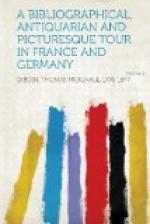[47] How long will this monument—(matchless
of its kind)—continue
unrepresented by the BURIN?
If Mr. Henry Le Keux were to execute it in
his best style, the world
might witness in it a piece of Art entirely
perfect of its kind.
But let the pencils of Messrs. Corbould and Blore
be first exercised on the
subject. In the mean while, why is GALLIC
ART inert?
[48] The choir was formerly separated from the surrounding
chapels, or
rather from the space between
it and the chapels, by a superb brass
grating, full of the most
beautiful arabesque ornaments—another
testimony of the magnificent
spirit of the Cardinal and Prime Minister
of Louis XII.: whose
arms, as well as the figure of his patron, St.
George, were seen in the centre
of every compartment ... The
Revolution has not left a
vestige behind!
[49] [In this edition, I put the above passage in
Italics,—to
mark, that, within three years
of writing it, the spire was consumed
by LIGHTNING. The newspapers
of both France and England were full of
this melancholy event; and
in the year 1823, Monsieur Hyacinthe
Langlois, of Rouen, published
an account of it, together with some
views (indifferently lithographised)
of the progress of the burning.
“It should seem (says
Mons. Licquet) that the author had a
presentiment of what was speedily
to take place:—for the rest, the
same species of destruction
threatens all similar edifices, for the
want of conductors.”
I possess a fragment of the lead of the roof, as
it was collected after a state
of fusion—and sent over to me
by some friend at Rouen.
The fusion has caused portions of the lead to
assume a variety of fantastic
shapes—not altogether unlike a
gothic building.]
[50] Let me add that the whole length of the cathedral
is about four
hundred and forty feet; and
the transept about one hundred and
seventy-five; English measure.
The height of the nave is about ninety,
and of the lantern one hundred
and sixty-eight feet, English. The
length of the nave is two
hundred and twenty-eight feet.
[51] He died in 1531. Both the ancient and yet
existing inscriptions are
inserted by Gilbert, from
Pommeraye and Farin; and formerly there was
seen, in the middle of the
monument, the figure of the Seneschal
habited as a Count, with all
the insignia of his dignity. But this did
not outlive the Revolution.




